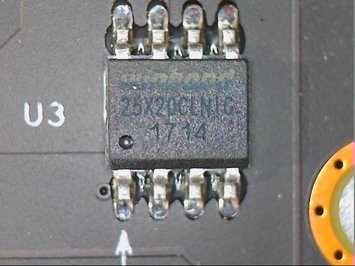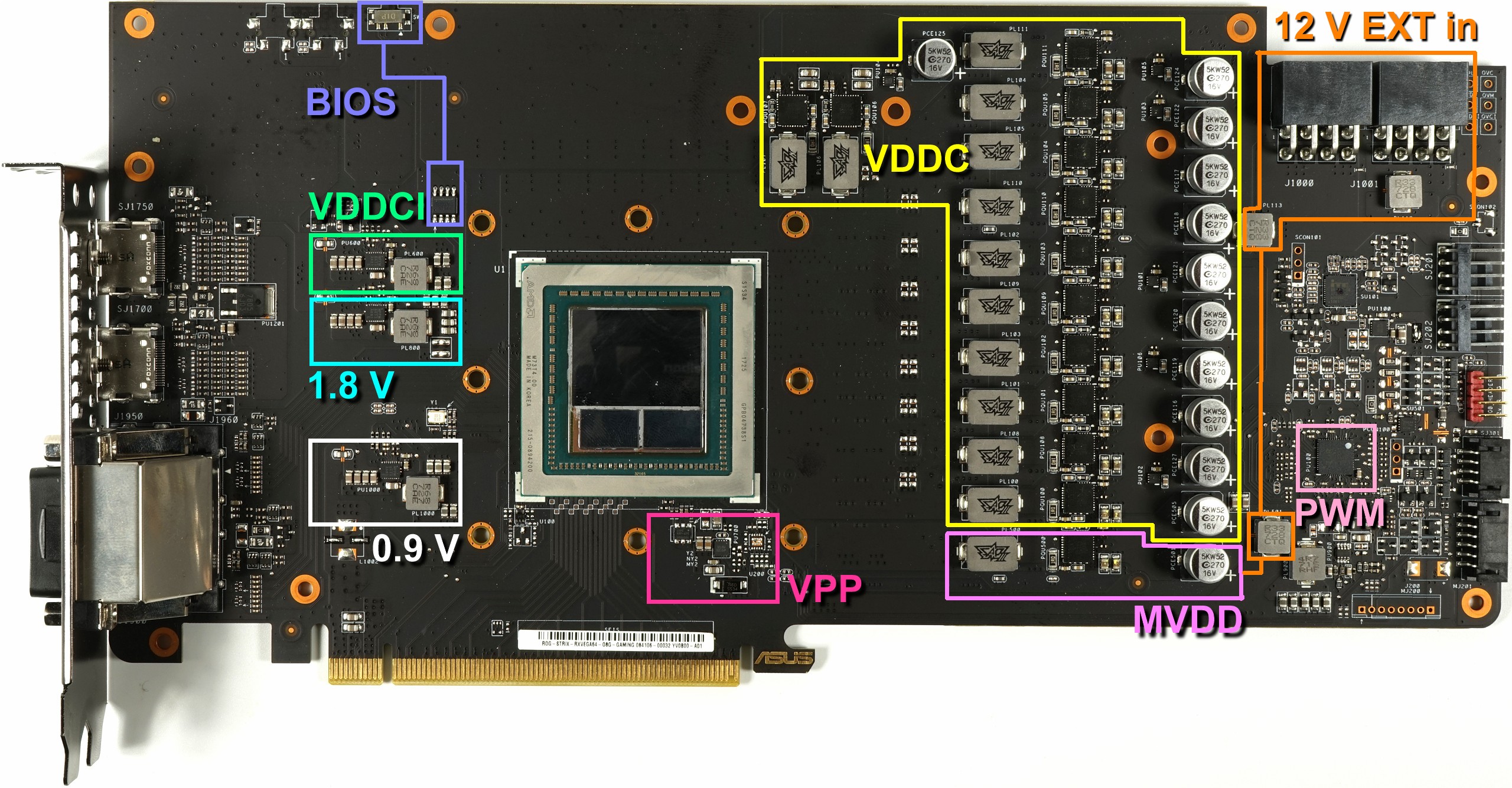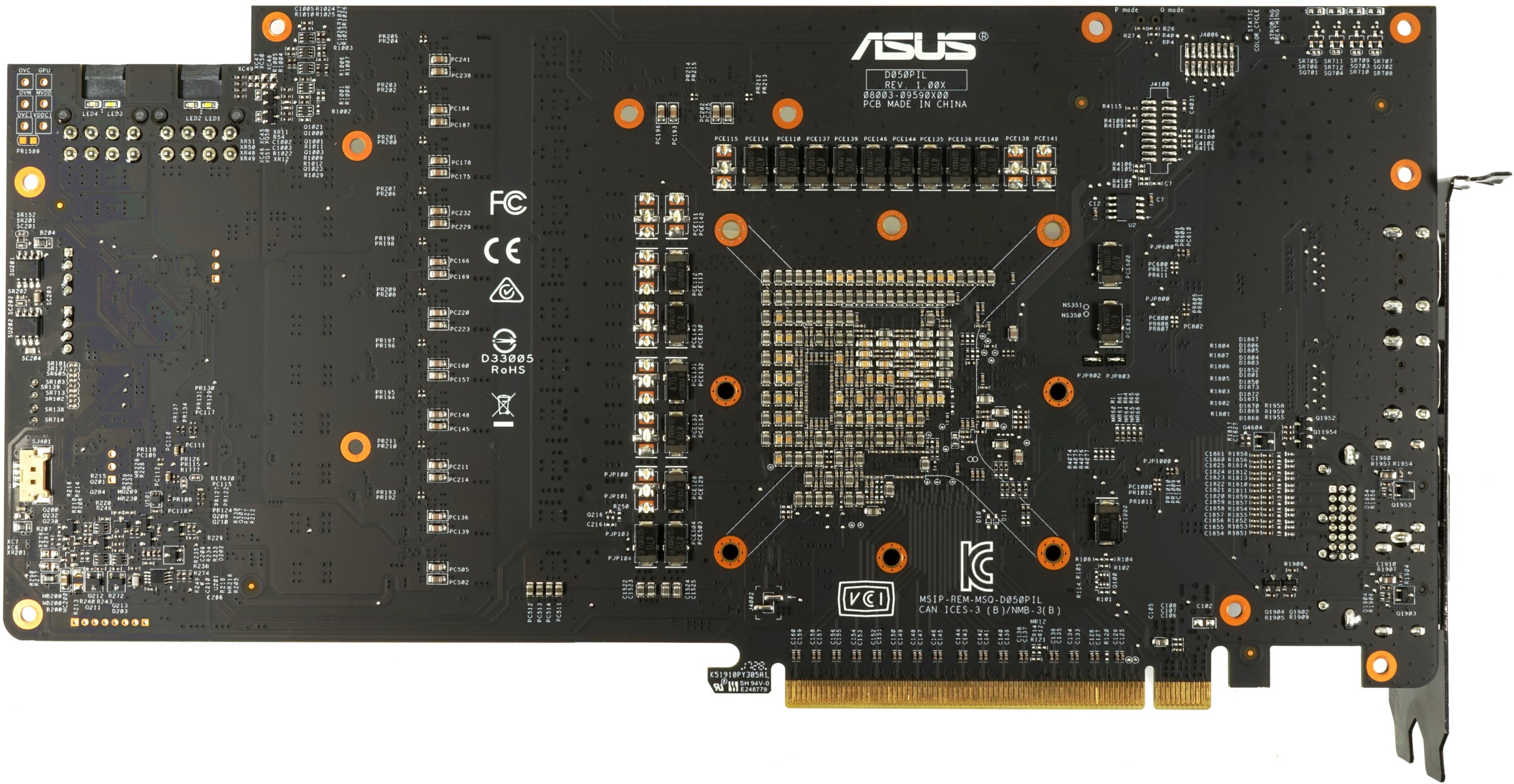Asus ROG Strix Radeon RX Vega 64 8GB OC Edition Review: High-End Graphics With Flair
Why you can trust Tom's Hardware
Board & Power Supply
Board Layout
Like Gigabyte and Sapphire, Asus deviates significantly from AMD's reference layout. Unfortunately, this also means that the design is incompatible with most existing full-cover water coolers.
Asus implements six power phases with doubling, resulting in 12 voltage converters for the VDDC and one phase for the memory (MVDD), just like AMD. We're particularly interested in the way two of those VDDC converters were positioned. Since there was no more vertical space available, they were simply arranged to the left, and must therefore be cooled separately.
The sources of other auxiliary voltages are also visible in our layout diagram.
A look at the board's back side reveals very few active components. This would have allowed plenty of space for a heat-conducting pad between the PCB and backplate, which could have been used to draw thermal energy away from the voltage converters.
Asus implements a pair of eight-pin connectors to complement the PCIe slot's power delivery. Since our measurements show the motherboard slot only feeding this card 25-27W, those two connectors handle the rest.
GPU Power Supply (VDDC)
As with AMD's reference design, the focus is on International Rectifier's IR35217, a dual-output multi-phase controller that provides six phases for the GPU and an additional phase for the memory. But again, there are 12 regulator circuits, not just six. This is a result of doubling, allowing the load from each phase to be distributed between two regulator circuits.


A total of six International Rectifier IR3599 multipliers are used to double the controller's phase count. The actual voltage conversion of each converter circuit is performed by an IR3555M, also from International Rectifier. These so-called PowIRstage chips combine the high- and low-side MOSFETs, driver, and Schottky diode in a single, highly integrated circuit.
Get Tom's Hardware's best news and in-depth reviews, straight to your inbox.


Asus employs its specially-branded SAP II (Super Alloy Power) chokes for the VDDC and MVDD.
Memory Power Supply (MVDD)
As mentioned, the memory's power is controlled by International Rectifier's IR35217 as well. One phase is fully sufficient for this card, as its HBM2 is less demanding. As with the VDDC, an IR3555M is used, along with SAP II chokes for smoothing the output.


Additional Voltage Converters
Creating the VDDCI isn’t a very difficult task. But it's an important one since this regulates the transition between the internal GPU and memory signal levels. It’s essentially the I/O bus voltage between the GPU and memory. A constant source for 0.9V is generated as well, along with a 1.8V source (TTL, GPU GPIO). These three voltage converters are equipped almost identically, relying on an MPS MPQ8633 synchronous step-down converter.
Underneath the GPU, there’s an Anpec APL5620 low drop-out linear regulator, which provides the very low voltage for the phase locked loop (PLL) area.
Another striking feature is the Winbond 25X-series double SPI flash chip. Asus places the corresponding switch exactly where you'd find it on AMD's reference card.


In the input section, there is a 330nH ferrite-core choke that helps block load peaks. If you are looking for shunts, similar to what we've seen on Nvidia cards, you won't find them. Unfortunately, Vega doesn't support current flow control on the input side.


Asus relies on an ITE 8915FN universal and programmable embedded controller that implements fan control and RGB lighting effects.
MORE: Best Graphics Cards
MORE: Desktop GPU Performance Hierarchy Table
MORE: All Graphics Content

Igor Wallossek wrote a wide variety of hardware articles for Tom's Hardware, with a strong focus on technical analysis and in-depth reviews. His contributions have spanned a broad spectrum of PC components, including GPUs, CPUs, workstations, and PC builds. His insightful articles provide readers with detailed knowledge to make informed decisions in the ever-evolving tech landscape
-
darkchazz "Missing a thermal pad between PCB and backplate"Reply
My Strix GTX 1080 I got in July 2016 also has missing several thermal pads on the GDDR5X modules. Many others reported this issue too and I suppose they still haven't fixed it at the production line. -
Kaziel I just bought one for USD599 on June 6th and waiting for all the parts to arrive. I really hope it'll be okay in an NZXT H500 with the 2x stock fans as exhaust and 2x Noctua NF-A14 as intake.Reply
Do you guys think that my EVGA SuperNova 650 P2 will be able to handle an overclocked R5 2600x and this Asus Strix Vega 64? -
milkod2001 @KAZIELReply
That depends how many other components you also plan to connect: Sound Cards, HDDs, Blue Ray Players, etc, ect but i think it would be OK with 1 SSD and 1 HDD. -
Martell1977 It would have been interesting for Tom's to make the modification of adding the thermal pads and show how much of a difference it would really make. I wonder if ASUS felt it was a acceptable trade off between looks and functionality.Reply -
Kaziel Reply21047426 said:@KAZIEL
That depends how many other components you also plan to connect: Sound Cards, HDDs, Blue Ray Players, etc, ect but i think it would be OK with 1 SSD and 1 HDD.
Still waiting on parts to arrive.
CPU: R5 2600x
Cooling: Noctua NH-U12S, 3x 120 Fans and 2x 140 Fans
Motherboard: Asus Strix x470-F
RAM: Corsair Vengeance RGB 3466 C16 (2x 8gb)
GPU: Asus Strix RX Vega 64
Storage: Samsung Evo 860 (250gb) and Seagate 2TB Barracuda (7200 RPM 64MB Cache)
Planning on just letting Ryzen Master auto overclock the 2600x. For the Vega 64 I plan to do the widely suggested undervolt, +50% power, and overclock HBM2. I have used the calculators and they basically say it's fine, but then again I left everything at stock. Not sure what the values are yet for going about overclocking the two parts so unsure what to put in the calculator. -
tokeylokey66 KekReply
Price had went down a little but still a complete joke of a price. More power and heat than 1080 , cost more, released later. Sry Amd you better figure out better marketing and sale strategies or do better in the tech side of things preferably both. -
alextheblue Wow there's commenters that still don't have a clue about the impact of mining, which lingers on Vega to this day.Reply -
zodiacfml Where the undervolting benchmarks if it is mentioned that it is better for overclocking and the mentioned poor exhaust vents?Reply
I think the critique for most of the Vega 64s are the large PCBs. It deserves smaller PCBs such as found in the Vega 56s to improve cooling. -
bit_user Reply
Nice review, but some Far Cry 5 benchmark would've been nice.21047101 said:...
Newegg now has this card for $599, which I think is pretty close to MSRP.

